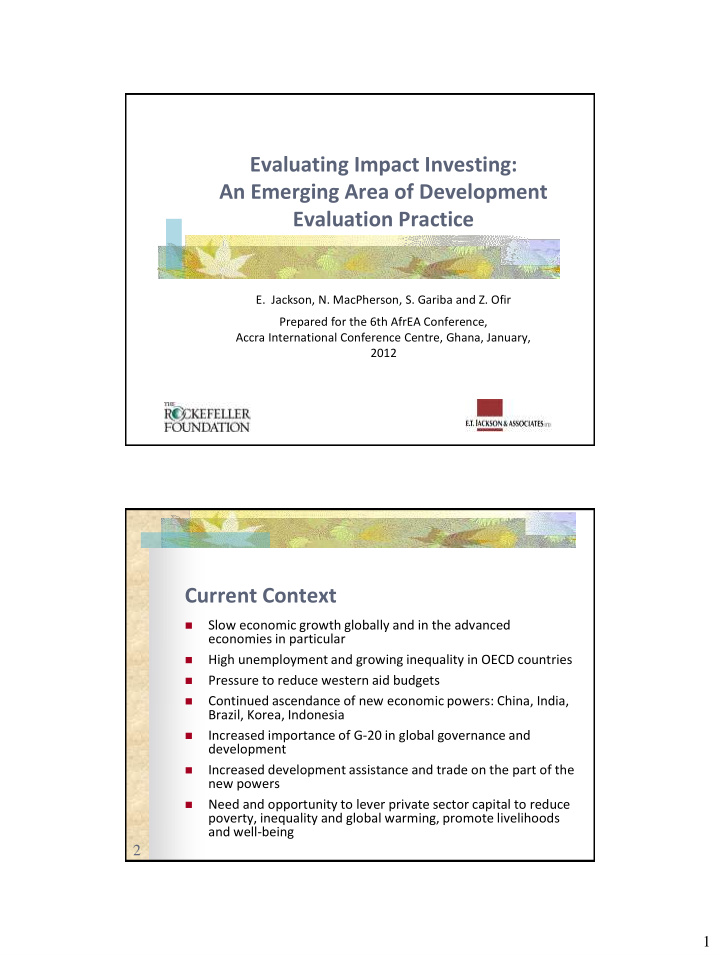



Evaluating Impact Investing: An Emerging Area of Development Evaluation Practice E. Jackson, N. MacPherson, S. Gariba and Z. Ofir Prepared for the 6th AfrEA Conference, Accra International Conference Centre, Ghana, January, 2012 Current Context Slow economic growth globally and in the advanced economies in particular High unemployment and growing inequality in OECD countries Pressure to reduce western aid budgets Continued ascendance of new economic powers: China, India, Brazil, Korea, Indonesia Increased importance of G-20 in global governance and development Increased development assistance and trade on the part of the new powers Need and opportunity to lever private sector capital to reduce poverty, inequality and global warming, promote livelihoods and well-being 2 1
New Options for Development Finance - Annual Flows, Driven by G-20 Countries Aid Commitments $80 B SWF Infrastructure Fund $ 8 B Financial Transaction Tax $ 9 B Remittances Transfer Savings $16 B Diaspora Bonds $ 4 B Fuel Tax (Global Component) $37 B Total $165 B (Gates Foundation, 2011) 3 A New Role for African Development Evaluators African stakeholders have a right and the responsibility to be at the table to shape new development finance instruments African evaluators have a right and the responsibility to ensure that meaningful development outcomes are being achieved by these new instruments Impact investing is a field in which African evaluators can, and should, play this role 4 2
3
Examples of Impact Investments Provision of below-market loans by a development finance institution to small businesses in a post-conflict zone Provision of loan guarantees (as program – related investments, or PRIs) by charitable foundations in an affordable housing fund, which then can lever additional commercial finance Purchase of the securitized debt of a microfinance loan portfolio by a commercial bank on commercial terms, which helps the MFI expand its lending Purchase by private investors of shares or units in a green energy fund that, in turn, invests in local renewable energy facilities in poor communities 7 4
Issues to be Engaged Going Forward Integrating II’s supply and demand sides Engaging the larger players in II: pension funds, sovereign wealth funds, major corporations Understanding and resolving the different cultures and practices of the II and development evaluation fields Balancing metrics, data and performance assessment at the centralized and decentralized levels Making the business case for SROI studies “ Africanizing” the field of impact investing, at the global and country levels 11 Impact Investing Initiative-Theory of Change Housing Lives of poor and vulnerable improved Health Care The poor and vulnerable can Clean Water capture real benefits Sanitation Availability of affordable Income generating activities Physical environment improved Energy products and services improved expanded Wage-levels permit real income gains for the poor Profitability of businesses ensure surplus for allocation to impacts Private business Small and medium Micro enterprises Social enterprises Local impact investment corporations engaged enterprises engaged engaged engaged funds engaged Number and size of for-profit impact investments increased Global economic conditions encourage investing Source: E.T. Jackson and Associates Ltd., 2011 Regulatory, fiscal and reputational incentives encourage investing Pension funds �– public Foundations, Private equity Non-profit social / Government Retail investors Family offices private �– engaged endowments engaged funds engaged green funds engaged agencies engaged engaged engaged �– For-profit impact investment efficiently placed by full ecosystem Cost-sharing by partners is sustained Competing �,�Q�W�H�U�P�H�G�L�D�U�L�H�V�¶�� �E�X�V�L�Q�H�V�V�� Coalition-building drives policy change systems co-exist models sustain expansion Collective action Industry infrastructure Intermediaries Policy reforms developed platforms created scaled instituted Catalyzing activities undertaken Grants for Grants for Grants for scaling PRIs for scaling Grants for research Communications Brokerage and collective action industry standards intermediaries intermediaries and advocacy outreach networking platforms approved approved approved approved executed carried out carried out 12 6
�t�Z�������u���l���������Z�]�����&�]�� Enabling environment scrutiny / transparency; • Governments risk of the • Foundations • Enterprises global financial movements Market where ���X�Q�H�[�S�H�F�W�H • Banks • Cooperatives (intern.) policy coherence the exchange • Investment funds • Projects occurs • Pension funds • Other efforts in need of capital Supply side • Financial instruments Demand side (providers of • ‘Buyers’/‘sellers’ interact on (in need of novel instruments, terms of trade, pricing, etc. capital) capital) mechanisms common standards, organizational culture, ethics motivation, processes Partnerships, networks and platforms 15 What Evaluation Methods are Most Relevant to Impact Investing? Methods and processes that provide for measurement, accountability, and understanding through ‘learning’, c ustomized to each assignment Methods that can be applied at multiple levels - on the supply and demand sides: e.g. individual, household, enterprise, program, ‘change’, fund, field, system Methods that distinguish between groups, e.g. for equity issues Methods that deal with systems and emergence Methods that incorporate understanding of, and tools for, assessing financial returns and business performance and viability 16 8
Range of Approaches and Methods �t some examples Clarifying the change logic(s), and understanding how, why, under : �`�Z���������]�������u�������v���������������������P e.g., theory-based evaluation (Carol Weiss, Huey Chen) theories of change / program theory analysis (Funnel & Rogers, 2011) Realistic Evaluation (Pawson 2010, Pawson & Tilley, 2006) Making provision for emergence, turbulence, ( fast)-changing contexts: Developmental evaluation (Patton, 2010) Understanding systemic change (integrating the components of the II Systems concepts in action (Williams & Hummelbrunner, �Z���˙�������u�[�W�� 2011; Williams & Iman, 2007); Realistic Evaluation; etc. 17 Range of Approaches and Methods �t some examples Evaluating specific components: organizational assessment (IDRC / Universalia model); network evaluation (Raynor, 2011); policy evaluation (e.g., Pawson 2010) ���v�������]�v�P���Z���}�]�����[�U���������o�]���˙�����Z�� e.g., stakeholder engagement (Chevalier & Buckles, 2008); utilization focused evaluation (Patton, 2010) Understanding and assessing (un)expected impact: range of impact evaluation approaches and designs – ref. 3ie, NONIE, IE4ID, InterAction Guidance (2012); contribution analysis (e.g., Mayne, 2008); unexpected consequences and impacts (Morell, 2010) Valuing beyond direct financial returns: Social return on investment - SROI (e.g. New Economics Foundation, REDF); environmental impact assessment; expanded value added statement (Mook, Quarter and Richmond, 2007); And many more 18 9
Recommend
More recommend